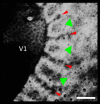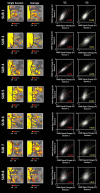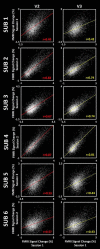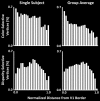Interdigitated Color- and Disparity-Selective Columns within Human Visual Cortical Areas V2 and V3
- PMID: 26865609
- PMCID: PMC4748071
- DOI: 10.1523/JNEUROSCI.3518-15.2016
Interdigitated Color- and Disparity-Selective Columns within Human Visual Cortical Areas V2 and V3
Abstract
In nonhuman primates (NHPs), secondary visual cortex (V2) is composed of repeating columnar stripes, which are evident in histological variations of cytochrome oxidase (CO) levels. Distinctive "thin" and "thick" stripes of dark CO staining reportedly respond selectively to stimulus variations in color and binocular disparity, respectively. Here, we first tested whether similar color-selective or disparity-selective stripes exist in human V2. If so, available evidence predicts that such stripes should (1) radiate "outward" from the V1-V2 border, (2) interdigitate, (3) differ from each other in both thickness and length, (4) be spaced ∼3.5-4 mm apart (center-to-center), and, perhaps, (5) have segregated functional connections. Second, we tested whether analogous segregated columns exist in a "next-higher" tier area, V3. To answer these questions, we used high-resolution fMRI (1 × 1 × 1 mm(3)) at high field (7 T), presenting color-selective or disparity-selective stimuli, plus extensive signal averaging across multiple scan sessions and cortical surface-based analysis. All hypotheses were confirmed. V2 stripes and V3 columns were reliably localized in all subjects. The two stripe/column types were largely interdigitated (e.g., nonoverlapping) in both V2 and V3. Color-selective stripes differed from disparity-selective stripes in both width (thickness) and length. Analysis of resting-state functional connections (eyes closed) showed a stronger correlation between functionally alike (compared with functionally unlike) stripes/columns in V2 and V3. These results revealed a fine-scale segregation of color-selective or disparity-selective streams within human areas V2 and V3. Together with prior evidence from NHPs, this suggests that two parallel processing streams extend from visual subcortical regions through V1, V2, and V3.
Significance statement: In current textbooks and reviews, diagrams of cortical visual processing highlight two distinct neural-processing streams within the first and second cortical areas in monkeys. Two major streams consist of segregated cortical columns that are selectively activated by either color or ocular interactions. Because such cortical columns are so small, they were not revealed previously by conventional imaging techniques in humans. Here we demonstrate that such segregated columnar systems exist in humans. We find that, in humans, color versus binocular disparity columns extend one full area further, into the third visual area. Our approach can be extended to reveal and study additional types of columns in human cortex, perhaps including columns underlying more cognitive functions.
Keywords: high-resolution fMRI; stereoscopic depth; streams; stripes; visual features.
Copyright © 2016 Nasr et al.
Figures
















Similar articles
-
Columnar organization of mid-spectral and end-spectral hue preferences in human visual cortex.Neuroimage. 2018 Nov 1;181:748-759. doi: 10.1016/j.neuroimage.2018.07.053. Epub 2018 Jul 25. Neuroimage. 2018. PMID: 30053514 Free PMC article.
-
Columnar Segregation of Magnocellular and Parvocellular Streams in Human Extrastriate Cortex.J Neurosci. 2017 Aug 16;37(33):8014-8032. doi: 10.1523/JNEUROSCI.0690-17.2017. Epub 2017 Jul 19. J Neurosci. 2017. PMID: 28724749 Free PMC article.
-
A hierarchy of the functional organization for color, form and disparity in primate visual area V2.Vision Res. 2001;41(10-11):1333-49. doi: 10.1016/s0042-6989(01)00076-1. Vision Res. 2001. PMID: 11322978
-
Human cortical areas underlying the perception of optic flow: brain imaging studies.Int Rev Neurobiol. 2000;44:269-92. doi: 10.1016/s0074-7742(08)60746-1. Int Rev Neurobiol. 2000. PMID: 10605650 Review.
-
The circuitry of V1 and V2: integration of color, form, and motion.Annu Rev Neurosci. 2005;28:303-26. doi: 10.1146/annurev.neuro.28.061604.135731. Annu Rev Neurosci. 2005. PMID: 16022598 Review.
Cited by
-
What is feasible with imaging human brain function and connectivity using functional magnetic resonance imaging.Philos Trans R Soc Lond B Biol Sci. 2016 Oct 5;371(1705):20150361. doi: 10.1098/rstb.2015.0361. Philos Trans R Soc Lond B Biol Sci. 2016. PMID: 27574313 Free PMC article. Review.
-
Columnar organization of mid-spectral and end-spectral hue preferences in human visual cortex.Neuroimage. 2018 Nov 1;181:748-759. doi: 10.1016/j.neuroimage.2018.07.053. Epub 2018 Jul 25. Neuroimage. 2018. PMID: 30053514 Free PMC article.
-
Abnormal Low-Frequency Oscillations Reflect Abnormal Eye Movement and Stereovision in Patients With Comitant Exotropia.Front Hum Neurosci. 2021 Oct 8;15:754234. doi: 10.3389/fnhum.2021.754234. eCollection 2021. Front Hum Neurosci. 2021. PMID: 34690728 Free PMC article.
-
Multivoxel Pattern of Blood Oxygen Level Dependent Activity can be sensitive to stimulus specific fine scale responses.Sci Rep. 2020 May 5;10(1):7565. doi: 10.1038/s41598-020-64044-x. Sci Rep. 2020. PMID: 32371891 Free PMC article.
-
7 Tesla and Beyond: Advanced Methods and Clinical Applications in Magnetic Resonance Imaging.Invest Radiol. 2021 Nov 1;56(11):705-725. doi: 10.1097/RLI.0000000000000820. Invest Radiol. 2021. PMID: 34510098 Free PMC article. Review.
References
-
- Adams DL, Zeki S. Functional organization of macaque V3 for stereoscopic depth. J Neurophysiol. 2001;86:2195–2203. - PubMed
Publication types
MeSH terms
Substances
Grants and funding
LinkOut - more resources
Full Text Sources
Other Literature Sources
